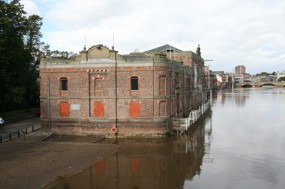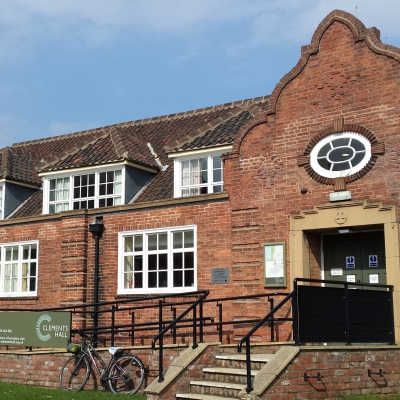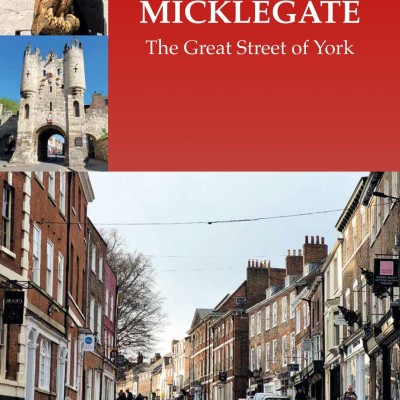25th March 2025
Memories of the Bonding Warehouse
We recently held our 2025 AGM at the Bonding Warehouse by the river, a great venue for community groups, with wonderful riverside views. It features in our latest book 'Bishophill and Skeldergate: exploring old shops, pubs and industries in York'. and is also the starting point for our new walk leaflet, 'A Walk around Historic Bishophill in York.'
The Bonding Warehouse has a long history. It’s a well-known building at the southern end of Skeldergate. Now Grade II listed, it was built in two stages, the northern block dates from 1872-3 and the southern block from 1875. It was originally known as the Bonded Warehouse, as it was where custom house officials stored goods such as wines and spirits before duty was paid.
 A handsome building, inside there are brick-vaulted ceilings on the ground floor, supported on cast-iron columns. If you look carefully in the ceiling, you can see where the old spiral sack chute was housed. It would have transported sacks of cocoa beans, brown sugar, peanuts or other commodities from upper floors to the ground floor in the working warehouse. It was lost prior to Grantside taking over the development, taken out of the building by the previous developers.
A handsome building, inside there are brick-vaulted ceilings on the ground floor, supported on cast-iron columns. If you look carefully in the ceiling, you can see where the old spiral sack chute was housed. It would have transported sacks of cocoa beans, brown sugar, peanuts or other commodities from upper floors to the ground floor in the working warehouse. It was lost prior to Grantside taking over the development, taken out of the building by the previous developers.
Historically, the Bonding Warehouse symbolises the importance of the river in the commercial life of York for many centuries. The common crane stood here in mediaeval times, and the port of York was managed and controlled around here for centuries.
You might not know that there was originally a ferry crossing the Ouse here at the end of Skeldergate from at least 1541, later let by the Corporation of York in the 18th century. The Gilliam family were lessees of the Skeldergate Ferry for a long time from 1732 until around 1860. A famous sailor’s epitaph, Tom Bowling, by Charles Dibdin, is reputed to be about the son of a Skeldergate ferryman.
Wilkie Collins painted a distinctive picture of mid-19th century Skeldergate in his 1862 novel, No Name. Together with Charles Dickens, he was a regular visitor to the city. He wrote about this end of Skeldergate ‘at its southward extremity the street ceases on a sudden, and the broad flow of the Ouse, the trees, the meadows, the public-walk on one bank and the towing-path on the other, open to view.’
In 1873 the Corporation reported that more than 800 people a day were using the ferry crossing, leading to a campaign for a bridge across the river here, and eventually Skeldergate Bridge was built and opened as a toll bridge in 1881.
By the 20th century a decline in commercial traffic along the River Ouse led to a reduction in business for warehouses along here, and it closed in 1958. It was used by Rowntree’s at one time.
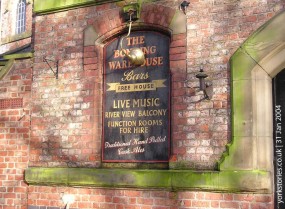 Owned by the council, it was leased out in the 1970s and 1980s.
Owned by the council, it was leased out in the 1970s and 1980s. 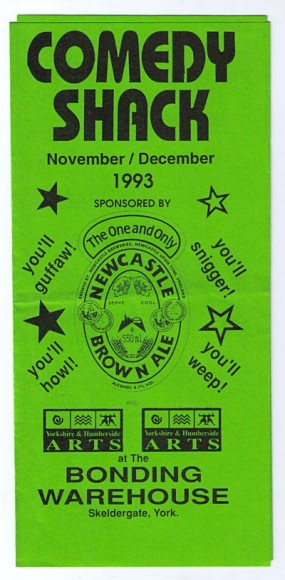 Many York people will have fond memories of the pub and steak house in 1981 and then a music and comedy venue in the 1990s, with Jo Brand, Mark Thomas, Dave Gorman, Rhona Cameron, Lee Evans and Jeremy Hardy playing here, among many. Simon Pegg was a ‘talented newcomer’. Did you come and see them here?
Many York people will have fond memories of the pub and steak house in 1981 and then a music and comedy venue in the 1990s, with Jo Brand, Mark Thomas, Dave Gorman, Rhona Cameron, Lee Evans and Jeremy Hardy playing here, among many. Simon Pegg was a ‘talented newcomer’. Did you come and see them here?

